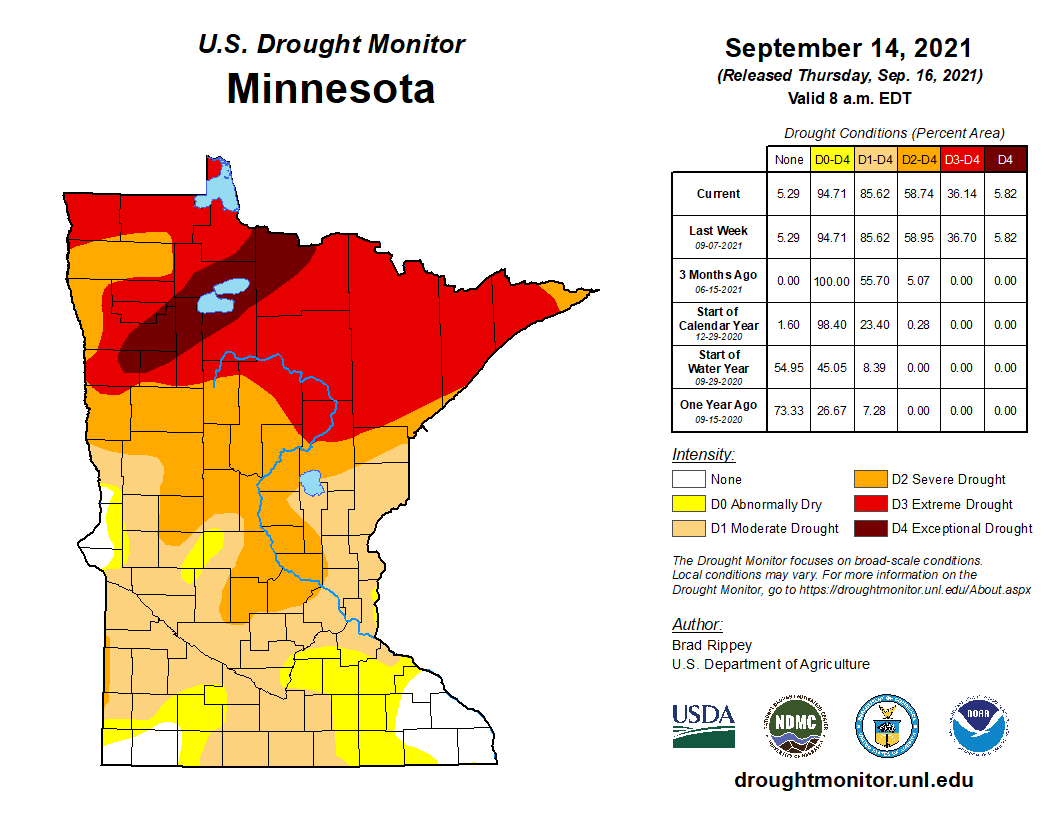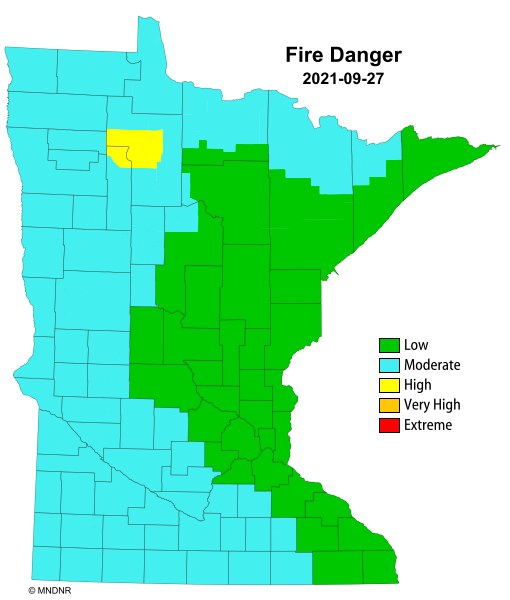Weekly Drought Update - Sept. 27, 2021
Key Points in this Update
Drought:
- Rainfall over the past week has led to a significant improvement in drought conditions. As of Sept. 21, 27 percent of the state is experiencing severe drought (up from 23 percent last week), 24 percent is experiencing extreme drought (down from 30 percent last week) and 0 percent of the state is experiencing exceptional drought (down from 6 percent last week).
- The state continues in the Drought Warning Phase. Water suppliers in the Rainy River and the Red River watersheds remain in the restrictive phase. The Mississippi Headwaters and Western Lake Superior remain in the warning phase. The St. Croix, Minnesota, and several southern watersheds were relaxed to the drought watch phase.
- As of Sept. 23, there are 15 active well interference investigations in six counties and one additional case is in the resolution phase.
Streamflow:
- 22 out of 81 total major surface water watersheds are below the Q90. Two watersheds dropped below their respective Q90 (minimum flow) this week. Six watersheds have experienced increased flows and are now above the minimum flow (Q90) threshold after being below in the previous week.
- 180 surface water appropriation permits out of 517 reviewed for potential permit suspension are currently suspended across 24 watersheds throughout the state.
Fire danger:
- As of Sept. 27, fire danger remains low to moderate throughout most of the state, with high fire danger in two north-central counties.
- As of Sept. 23, burning permits are still required in all counties. There are no other designated burning restrictions.
- As of Sept. 23, the Greenwood Fire, 10 miles SW of Isabella, is at 26,797 acres in size (41 square miles) and is 80% contained. Maximum containment has peaked, as wetland areas prevent crew and equipment from building containment lines in those areas.
Sample Lake Level situation:
- Seven of the ten reporting lakes increased from the previous week, from 0.12 to 2.4 inches.
- Three of the ten reporting lakes decreased from the previous week, from 0.36 to 1.68 inches.
- Three of the ten lakes remain in the low range.
- One of the ten lakes is in the below normal range
- Six of the ten lakes are in the normal range.
Drought Information
Last two weeks of Drought Maps:
  Links to the maps
Drought situation:
- Counties with an area of exceptional drought (D4): 0
- Counties with an area of extreme drought (D3): 19
- Counties with an area of severe drought (D2): more than 25
- Counties with an area of moderate drought (D1): more than 40
- Counties just abnormally dry (D0 – not drought): 7
- Counties with no designation: 3
- Estimated population in Drought Areas: 4,237,297
Drought management actions:
- The state remains in the drought warning phase of the Statewide Drought Plan.
- The Rainy River and Red River watersheds continue to experience extreme to exceptional drought and water suppliers remain in the restrictive phase. The St. Croix, Minnesota, Missouri, Des Moines and Upper Mississippi-Iowa-Wapsipinicon watersheds were relaxed to the drought watch phase this week.
- The St. Croix, Minnesota, Missouri, Des Moines and Upper Mississippi-Iowa-Wapsipinicon watersheds were relaxed to the drought watch phase this week.
- As of Sept. 23, the DNR has received 22 well interference complaint forms in six counties. Details are available on the DNR Well Interference webpage.
- 15 are active investigations.
- Two were found valid; one is concluded and one is in resolution/negotiation phase.
- One was found not valid.
- Two was dismissed.
- Two were resolved early by the appropriator.
- The DNR has received 32 verbal complaints, four of which were resolved by nearby appropriators.
Streamflow Information
 Link to the map
Streamflow situation:
- Watersheds at minimum flow (below Q90): 21 watersheds (Lake Superior – North, , St. Louis River, Cloquet River, Mississippi River-Grand Rapids, Mississippi River – Brainerd, Pine River, Mississippi River – St. Cloud, Crow Wing River, Redeye River, Marsh River, Two River, Roseau River, Lake of the Woods, Rainy River – Headwaters, Vermillion River, Rainy River – Rainy Lake, Rainy River – Manitou, Little Fork River, Big Fork River, Rapid River, and Rainy River).
- Watersheds at low flow: 4 watersheds are experiencing low flow.
- Watersheds at normal flow: 52 watersheds are experiencing normal flow conditions.
- Watersheds at high flows: 4 watersheds are experiencing high flows.
Streamflow management actions:
- 180 surface water appropriation permits are currently suspended across 24 watersheds including the St. Louis River, Cloquet River, Mississippi River – Brainerd, Pine River, Crow Wing River, Redeye River, Rapid River, Rainy River – Baudette, Sand Hill River, Little Fork River, Rainy River – Headwaters, Big Fork River, Rainy River – Manitou, Mississippi River – Grand Rapids, Red Lake River, Clearwater River, Thief River, Roseau River, Lake of the Woods, Two River , Lake Superior – North, Mississippi River – St. Cloud, Snake River, Lower St. Croix River, Mississippi River – Lake Pepin, and Watonwan River watersheds.
- Two watersheds dropped below the Q90 within the last week. Six watersheds increased above the local Q90.
- Permit reinstatements following temporary suspension due to minimum flows:
- Wild Rice River (No. 60): 6 surface water appropriation permits were reinstated on September 10.
- Mississippi River – Sartell (No. 15) and Sauk River (No. 16): 42 surface water appropriation permits were reinstated on September 9, including four surface water appropriation permit holders that were implementing their contingency plan.
- Bois de Sioux River (No. 54) and Mustinka River (No. 55): 8 surface water appropriation permits were reinstated on September 8.
- Other permit actions in watersheds at minimum flow (below the Q90) include:
- Watonwan River (No. 31): 15 surface water appropriation permits were suspended on August 25. Flows at the designated stream flow gage near Garden City continue above the Q90 this week.
- Mississippi River – Lake Pepin (No. 38): 9 surface water appropriation permits were suspended on August 25. Flows at the designated stream flow gage in Empire continue above the Q90 this week.
- Snake River (No. 36) and Lower St. Croix River (No. 37): 16 surface water appropriation permits were suspended on August 24. One surface water appropriation permit holder is implementing their contingency plan through the use of a groundwater well in lieu of their surface water appropriation. Flows at the designated stream flow gage near Pine City continue above the Q90 this week.
- Mississippi River – St. Cloud (No. 17): 25 surface water appropriation permits were suspended on August 24. Four surface water appropriation permit holders are implementing their contingency plan through the use of a groundwater well in lieu of their surface water appropriation. Flows at the designated stream flow monitoring gage near Big Lake increased above the Q90 this week.
- Lake Superior – North (No. 1): 2 surface water appropriation permits were suspended on August 17.
- Red Lake River (No. 63): 15 surface water appropriation permits were suspended on August 4. Flows at the designated stream flow gage at Crookston increased above the Q90 this week.
- Clearwater River (No. 66): 14 surface water appropriation permits were suspended on August 4. Flows at the designated stream flow gage at Plummer increased above the Q90 this week.
- Roseau River (No. 71): 1 surface water appropriation permit was suspended on August 2.
- Thief River (No. 65): One surface water appropriation permit was reinstated on September 2. Flows at the designated stream flow monitoring gage near Thief River Falls increased above the Q90 this week.
- Little Fork River (No. 76): 3 surface water appropriation permits were suspended on July 28.
- Rainy River – Headwaters (No. 72): 1 surface water appropriation permit was suspended on July 28.
- Rainy River – Manitou (No. 75) and Big Fork River (No. 77): 2 surface water appropriation permits were suspended on July 28.
- Mississippi River – Grand Rapids (No. 9): 19 surface water appropriation permits were suspended on July 27.
- Sand Hill River (No. 61): 8 surface water appropriation permits were suspended on July 24. Flows at the designated stream flow gage in Climax continue above the Q90, but not enough to reinstate suspended permits.
- Mississippi River – Brainerd (No. 10) and Pine River (No. 11) watersheds: 21 surface water appropriation permits were suspended on July 13.
- Rapid River (No. 78) and Rainy River - Baudette (No. 79) watersheds: 3 surface water appropriation permits were suspended on July 13. Flows at the designated stream flow gage on the Roseau River near Malung increased above the Q90, but not enough to reinstate suspended permits.
- Louis River (No. 3) and Cloquet River (No. 4) watersheds: 6 surface water appropriation permits were suspended on July 11. Additionally, 3 permits have contingency plans to modify their appropriation under the existing permits.
- Crow Wing River (No. 12) and Redeye River (No. 13): 17 surface water appropriation permits were suspended on June 28. Flows at the designated stream gage at Nimrod continue above the Q90 this week.
- The Marsh River watershed (No. 59) does not have any surface water appropriation permits and flows continue to be below the Q90.
- The Vermillion River (No. 73) and Rainy River – Rainy Lake (No. 74) watersheds include only two non-consumptive water-use permits, resulting in no suspensions.
- The Lake of the Woods (No. 80) watershed does not have any surface water appropriation permits.
- The DNR will reinstate permits when the average daily flow exceeds, for at least 72 hours, the Q90 plus the cumulative instantaneous total of all suspended appropriations from contributing surface water sources within the watershed. Consideration of anticipated precipitation or lack thereof is also a factor in determining when to reinstate suspended permits.
- We continue to watch the changing streamflow conditions and suspend or reinstate surface water appropriation permits where and when necessary.
Fire Danger and Management
  Link to the maps
Fire danger analysis:
(Fire danger conditions can change daily based on local meteorological variables. Information presented illustrates a real-time snap shot of current conditions on Sept. 27.)
- Counties with Extreme Fire Danger: 0
- Counties with Very High Fire Danger: 0
- Counties with High Fire Danger: 2
Fire management actions:
- As of Sept. 27, fire danger remains low to moderate throughout most of the state. There is some high fire danger in two north-central counties.
- As of Sept. 27, burning permits are still required in all counties. There are no other designated burning restrictions.
- As of Sept. 24, the Greenwood Fire, 10 miles SW of Isabella, is at 26,797 acres in size (41 square miles) and is 80% contained. Maximum containment has peaked, as wetland areas prevent crew and equipment from building containment lines in those areas.
- See Superior National Forest webpage for current fire information.
Lake Water Levels
 Lake Level situation depicted on the map:
- Seven of the ten reporting lakes increased from the previous week, from 0.12 to 2.4 inches.
- Three of the ten reporting lakes decreased from the previous week, from 0.36 to 1.68 inches.
- Three of the ten lakes remain in the low range.
- One of the ten lakes is in the below normal range
- Six of the ten lakes are in the normal range.
The DNR LakeFinder non-mobile website provides available lake level elevations for individual lakes. Search by county, the lake’s name or eight-digit identification number for your lake, and then click on the Water Levels report. The Lake Water Level report page contains all available lake levels, highest and lowest lake levels, and a 10-year graph. All the reported historic and current lake elevations can be downloaded for viewing or copied to a spreadsheet for graphing and other functions.
|